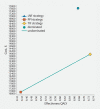Transoral incisionless fundoplication is cost-effective for treatment of gastroesophageal reflux disease
- PMID: 35845021
- PMCID: PMC9286770
- DOI: 10.1055/a-1783-9378
Transoral incisionless fundoplication is cost-effective for treatment of gastroesophageal reflux disease
Abstract
Background and study aims Given the sizable number of patients with symptomatic gastroesophageal reflux disease (GERD) despite proton pump inhibitor (PPI) therapy, non-pharmacologic treatment has become increasingly utilized. The aim of this study was to analyze the cost-effectiveness of medical, endoscopic, and surgical treatment of GERD. Patients and methods A deterministic Markov cohort model was constructed from the US healthcare payer's perspective to evaluate the cost-effectiveness of three competing strategies: 1) omeprazole 20 mg twice daily; 2) transoral incisionless fundoplication (TIF 2.0); and 3) laparoscopic Nissen fundoplication [LNF]. Cost was reported in US dollars with health outcomes recorded in quality-adjusted life years (QALYs). Ten-year and lifetime time horizons were utilized with 3 % discount rate and half-cycle corrections applied. The main outcome was incremental cost-effectiveness ratio (ICER) with a willingness-to-pay threshold of $ 100,000 per QALY. Probabilistic sensitivity analyses were also performed. Results In our base-case analysis, the average cost of TIF 2.0 was $ 13,978.63 versus $ 17,658.47 for LNF and $ 10,931.49 for PPI. Compared to the PPI strategy, TIF 2.0 was cost-effective with an incremental cost of $ 3,047 and incremental effectiveness of 0.29 QALYs, resulting in an ICER of $ 10,423.17 /QALY gained. LNF was strongly dominated by TIF 2.0. Over a lifetime horizon, TIF 2.0 remained the cost-effective strategy for patients with symptoms despite twice-daily 20-mg omeprazole. TIF 2.0 remained cost-effective after varying parameter inputs in deterministic and probabilistic sensitivity analyses and for scenario analyses in multiple age groups. Conclusions Based upon this study, TIF 2.0 was cost-effective for patients with symptomatic GERD despite low-dose, twice-daily PPI.
The Author(s). This is an open access article published by Thieme under the terms of the Creative Commons Attribution-NonDerivative-NonCommercial License, permitting copying and reproduction so long as the original work is given appropriate credit. Contents may not be used for commercial purposes, or adapted, remixed, transformed or built upon. (https://creativecommons.org/licenses/by-nc-nd/4.0/).
Conflict of interest statement
Competing interests Thomas R. McCarty has no conflicts to disclose. Pichamol Jirapinyo has the following disclosures: Apollo Endosurgery – Research Support, Fractyl – Research Support, GI Dynamics – Research Support, Endogastric Solutions – Consultant. Lyndon P. James has no conflicts to disclose. Sanchit Gupta has no conflicts to disclose. Walter W. Chan has the following disclosures: Ironwood – scientific advisory board. Christopher C. Thompson has the following disclosures: Apollo Endosurgery – Consultant/Research Support (Consulting fees/Institutional Research Grants), Aspire Bariatrics – Research Support (Institutional Research Grant), BlueFlame Healthcare Venture Fund – General Partner, Boston Scientific – Consultant (Consulting fees), Covidien/Medtronic – Consultant (Consulting Fees), EnVision Endoscopy (Board Member), Fractyl – Consultant/Advisory Board Member (Consulting Fees), GI Dynamics – Consultant (Consulting Fees)/ Research Support (Institutional Research Grant), GI Windows – Ownership interest, Olympus/Spiration – Consultant (Consulting Fees)/Research Support (Equipment Loans), Spatz – Research Support (Institutional Research Grant), USGI Medical – Consultant (Consulting Fees)/Advisory Board Member (Consulting fees)/Research Support (Research Grant).
Figures




Similar articles
-
Cost-effectiveness of the RefluxStop device for management of refractory gastroesophageal reflux disease in Switzerland.J Med Econ. 2024 Jan-Dec;27(1):805-815. doi: 10.1080/13696998.2024.2362564. Epub 2024 Jun 18. J Med Econ. 2024. PMID: 38820006
-
Long-term cost-effectiveness of medical, endoscopic and surgical management of gastroesophageal reflux disease.Surgery. 2015 Jan;157(1):126-36. doi: 10.1016/j.surg.2014.05.027. Epub 2014 Sep 26. Surgery. 2015. PMID: 25262216
-
A cost-effectiveness analysis of RefluxStop against relevant therapeutic alternatives for chronic gastroesophageal reflux disease in Sweden.Expert Rev Pharmacoecon Outcomes Res. 2024 Oct 20:1-13. doi: 10.1080/14737167.2024.2417774. Online ahead of print. Expert Rev Pharmacoecon Outcomes Res. 2024. PMID: 39428644
-
Efficacy of transoral incisionless fundoplication for refractory gastroesophageal reflux disease: a systematic review and meta-analysis.Endoscopy. 2018 Jul;50(7):708-725. doi: 10.1055/a-0576-6589. Epub 2018 Apr 6. Endoscopy. 2018. PMID: 29625507
-
Transoral Incisionless Fundoplication for Refractory Gastroesophageal Reflux Disease: Where Do We Stand?Clin Endosc. 2016 Mar;49(2):147-56. doi: 10.5946/ce.2015.044. Epub 2016 Feb 15. Clin Endosc. 2016. PMID: 26878326 Free PMC article. Review.
Cited by
-
Diagnosis and treatment of patients with gastroesophageal reflux disease - a systematic review of cost-effectiveness and economic burden.BMC Health Serv Res. 2024 Nov 6;24(1):1351. doi: 10.1186/s12913-024-11781-8. BMC Health Serv Res. 2024. PMID: 39501242 Free PMC article.
-
American Society for Gastrointestinal Endoscopy guideline on the diagnosis and management of GERD: methodology and review of evidence.VideoGIE. 2024 Dec 18;10(2):81-137. doi: 10.1016/j.vgie.2024.10.001. eCollection 2025 Feb. VideoGIE. 2024. PMID: 40012897 Free PMC article.
-
Endoscopic Management Options for Gastroesophageal Reflux Disease.Cureus. 2024 Jun 10;16(6):e62069. doi: 10.7759/cureus.62069. eCollection 2024 Jun. Cureus. 2024. PMID: 38989395 Free PMC article. Review.
-
The role of transoral incisionless fundoplication (TIF) in the management of gastroesophageal reflux disease (GERD) following peroral endoscopic myotomy (POEM): A pilot, prospective, patient-driven study.Saudi J Gastroenterol. 2024 Jul 1;30(4):266-271. doi: 10.4103/sjg.sjg_22_24. Epub 2024 Mar 11. Saudi J Gastroenterol. 2024. PMID: 38465439 Free PMC article.
References
-
- Zagari R M, Fuccio L, Wallander M A et al.Gastro-oesophageal reflux symptoms, oesophagitis and Barrettʼs oesophagus in the general population: the Loiano-Monghidoro study. Gut. 2008;57:1354–1359. - PubMed
-
- Camilleri M, Dubois D, Coulie B et al.Prevalence and socioeconomic impact of upper gastrointestinal disorders in the United States: results of the US Upper Gastrointestinal Study. Clin Gastroenterol Hepatol. 2005;3:543–552. - PubMed
-
- Pace F, Bazzoli F, Fiocca R et al.The Italian validation of the Montreal Global definition and classification of gastroesophageal reflux disease. Eur J Gastroenterol Hepatol. 2009;21:394–408. - PubMed
-
- Vakil N, van Zanten S V, Kahrilas P.The Montreal definition and classification of gastroesophageal reflux disease: a global evidence-based consensus Am J Gastroenterol 20061011900–1920.; quiz 43 - PubMed
LinkOut - more resources
Full Text Sources

